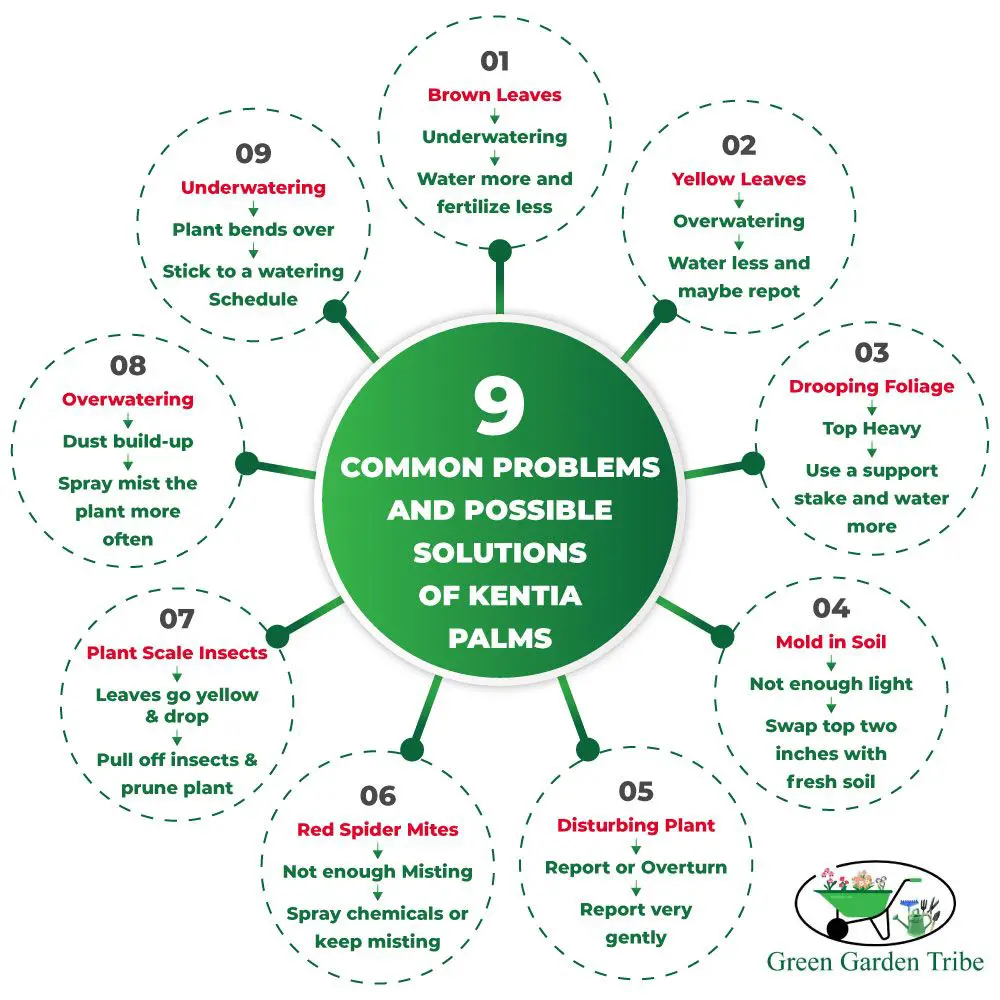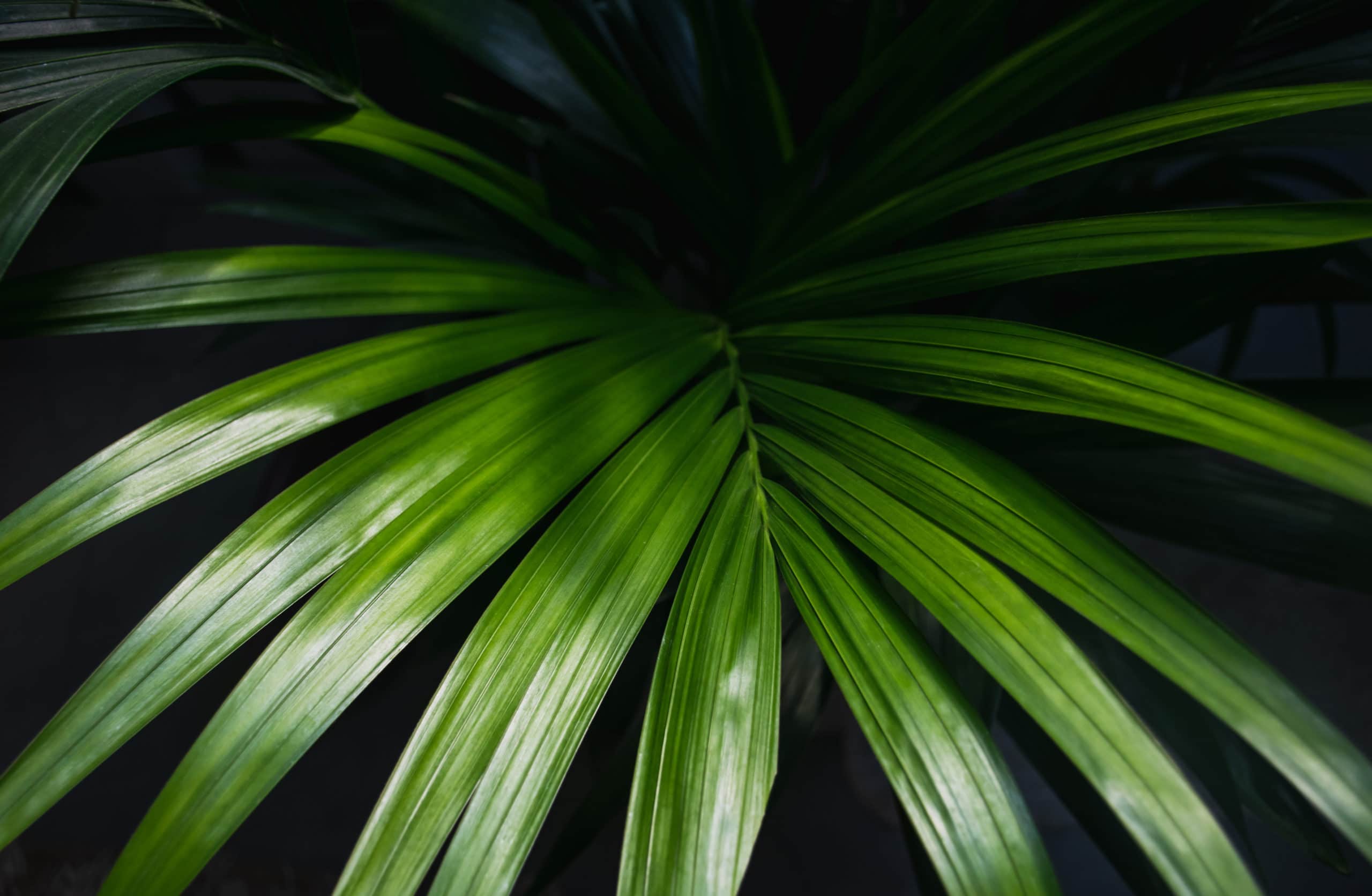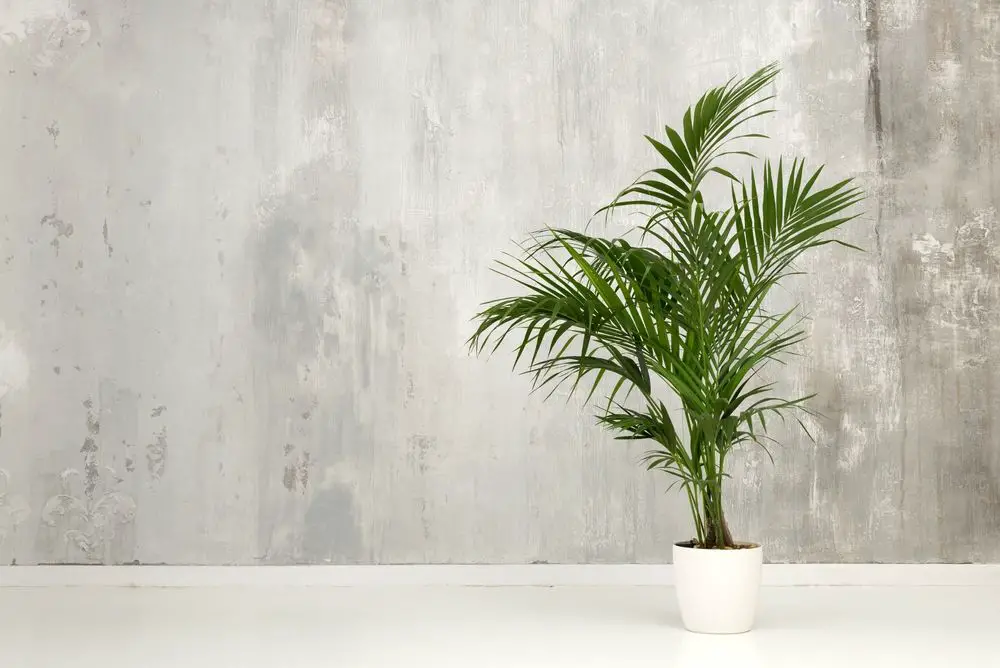We will discuss the Common Problems and Possible Solutions of Kentia Palms in this article.
Having Kentia Palms in your living room is an attractive way of adding charm to your home décor.
The Kentia Palm’s lush and tall green fan-like foliage can instantly give your home a tropical island ambiance.
Dealing with some Kentia Palm problems can cause you to enjoy the new and relaxed mood it offers.
The Nine Common Problems and Possible Solutions of Kentia Palms are: 
Common Problems and Solutions
To continuously enjoy your Kentia Palm, you need to watch out for these Kentia Palm problems so you can immediately address them.
1. Brown Leaves
The leaves of the Kentia Palm turn brown due to over-fertilizing. The Kentia Palm is a slow-growing cultivar, so it only needs occasionally fertilizing for healthy growth.
Highly concentrated fertilizer can also be too harsh for the Plant and cause its leaves to turn brown or burn. Whereas underwatering also causes the foliage to turn brown.
Solution:
Only water the Plant when you notice the top two inches of the soil look dry. When the Plant lacks moisture, then you have to provide it with adequate amounts of water.
You can use a soil pH and moisture meter to know the exact time you need to water your Kentia Palm. It’s not an expensive tool, but it does a lot to save your Plant.
If your Kentia Palm’s leaves are turning brown, try to cut down on fertilizing at that time.
Give the soil a good rinse to drain out excess salts from the fertilizer. When you return to fertilizer, make sure to follow the recommended ratio stated by the manufacturer.
2. Yellow Leaves
The yellowing of the leaves of the Kentia Palm is one of the most common issues faced by beginners. The yellowing of the leaves is often due to overwatering.
Excessive moisture, in addition to poor draining, will kill this Plant. Water will stagnate and make the roots rot and the leaves yellow.
Solution:
Aerating the soil is often enough to allow excess moisture to evaporate in minor cases. It would be best if you also let the soil dry out before the next watering session.
It may take a few weeks, so you need to be patient and not prematurely water the Plant.
If, after aeration, the leaves continue to yellow, this means root rotting has already begun. In this case, you will need to change the soil.
Make sure you use well-draining potting soil to ensure better draining.
Before repotting your Kentia Palm, trim out the mushy and brown parts of the roots to stop the progress of damage. A healthy plant root is firm to the touch and white.
3. Drooping Foliage
It is relatively normal to see the leaves of a plant droop from time to time. But, when the leaves slump too much, there is a clear indication that your Plant is not happy.
The heavy drooping of the leaves of your Kentia Palm is often because of under-watering. The Plant has dehydrated, and its fronds do not have enough energy to keep its leaves upright.
In certain instances, your Kentia Palm has drooping leaves because it’s top-heavy. This is a normal occurrence.
Solution:
If under watering is the leading cause for dropping leaves, you need to be more consistent in watering the Plant. You can frequently water the Plant to prevent it from dehydrating.
If being top-heavy is the reason for drooping leaves, provide support or a stake to the Plant to maintain its good structure. Tie the main stem of the Plant to the stake so it can support the weight of the leaves. This way, you’re training your Plant to always be in an upright position.

4. Mold in the Soil
When your Kentia Palm doesn’t get enough light or overwatering it, there will be mold growth on the soil.
Solution:
No one likes to have mold in their home. Remove the mold as soon as you notice it in the pot, to prevent it from spreading and eventually killing your Kentia Palm.
Take away mold from the soil by removing 2 inches of the top layer of the earth and then replace it with fresh soil.
At this point, increase the sun exposure of the Plant but never place it under direct sun.
Place the Kentia in an airy and lightroom to get all the sun it needs without exposing it to direct sunlight.
If it’s overwatered, then water less and ensure efficient water draining from the pot’s bottom. This will prevent not only mold spores in the soil but also root rotting.
5. Disturbing the Kentia Plant
Kentia plants hate to be disturbed because they can get shocked. These plants are incredibly sensitive and don’t want to be disturbed or moved, thus be careful when repotting the Kentia.
Repotting can cause your Kentia Palm a lot of stress and shock. A shock will cause its leaves to turn yellow. Their leaves will turn brown when they start to die.
Solution:
Repot the Kentia only when necessary and do it carefully and slowly. Twenty-four hours before repotting, soak the soil to lessen the shock. Repot as fast as you can and make sure not to touch the root system.
Plant the Kentia Palm in a big and beautiful pot, to begin with so as to avoid future repotting. Choose a pot that goes well with any interior, so just in case you decide to redecorate your home; you won’t need to put your Kentia Palm in another pot.
6. Red Spider Mites
Red spider mites and tiny red spiders show up as sticky cobwebs before they become spiders, so you may not notice their presence. While they are little pests, they can cause irreversible damage to your Kentia Palm when not treated immediately.
Red spider mites can damage your Kentia Palm by drawing liquid out of it and eventually killing the Plant.
Solution:
It can be challenging to get red spiders mites off your Kentia Palm, but you must get rid of them to prevent an infestation.
Red spider mites despise humidity and water, so you can get them off yourKentia by popping it in the shower at least once a week. Misting the Plant in between showers can also help get rid of red spider mites.
Spraying some chemicals, though, is a quicker way of getting rid of red spider mites.
But if you want to go organic or do not like to use chemicals, showering and misting the Kentia will eliminate the mites.
7. Plant Scale Insects
These types of insects suck the sap out of plants. Fully grown insects of this type will attach themselves to the Plant and suck all of the sap from its leaves.
When attacked by scale insects, the leaves of your Kentia Palm will turn yellow. They will then become mottled and will fall off.
Solution:
Check each leaf of your Kentia to prevent an insect outbreak. Look for any white marks that can indicate a plant-scale insect outbreak.
Pull off the scale insects by hand or with an alcohol-soaked cotton bud.
If you detect the problem early on, prune the part of the Kentia Palm to prevent them from spreading.
8. Overwatering
The Kentia Palm is easy to look after. It should be watered only when needed.
It is also good to mist your Kentia often to prevent dust build-up. Dust can often be a cause of other problems to the Plant.
Overwatering can kill your Kentia Palm. Kentia Palms are not capable of drawing water fast enough so it can cause the rotting of the roots.
Solution:
Check the soil often to see if the Plant needs watering. The Kentia Palm needs watering if the top layer of the earth is dry.
Make sure not to overwater because it will cause rotting of the roots.
It is also best to mist the Plant every so often to stop the build-up of dust. Misting also prevents spider mites from killing your Kentia.
9. Under-watering
Many problems can arise out of under-watering your Kentia Palm. It can cause the tips of the Plant’s leaves to turn yellow, die, and turn brown. The leaves can also become dry, brittle, and unhealthy.
Under-watering can also cause the stems of the Plant to bend and not stand upright.
Solution:
To ensure you are watering just enough, regularly check on your Plant. Check the leaves and stems for any changes in shape and color. It is also a good idea to stick to a regular watering schedule.
Ideal Growing Conditions
The Kentia Palm (Howea Forsteriana) is a tropical plant that can grow indoors between 3-12 feet tall and 2-4 feet wide when mature. It grows well in areas in hardiness zones 9-11 (USDA). It comes with white flowers that bloom in winter.
These plants are slow-growing. They thrive best in room temperatures from 65°F to 85°F or humid and warm environments
Preferring medium to the bright indirect sun, a Kentia Palm will do well in medium-low light. It will, however, burn when placed in direct sunlight. This growing condition makes them a great indoor plant.
This Plant loves to be slightly moist and does not like to be waterlogged or oversaturated. It should be watered when the top 2 inches of soil is dry.
Kentia Palms need to be fertilized at least once or twice every month in the spring and the summer with slow-release fertilizer, foliar feed, or indoor plant food.
Final Thoughts on Kentia Palm Problems and Possible Solutions
Kentia Palms are sturdy. They do not require too much care. But just like all cultivars, they are not invincible.
It is common to have Kentia Palm problems. The most important thing is to detect these problems early, so possible solutions are enforced to prevent too much damage or even death to your Kentia Palm.
The beauty and many benefits of Kentia Palms have made it a much favored indoor plant by many homeowners.
The Kentia Palm is relatively easy to maintain, which makes it a popular houseplant.
One exciting aspect of the Kentia Palm is that it’s a great air purifier! Take advantage of this and place your Kentia in areas of your home that have unwanted odors – on the condition that the Kentia will be happy in that part of your house.
This article has discussed the nine common problems and possible solutions of Kentia Palms in a relatively comprehensive fashion.
We hope this has helped you understand the plant’s needs and will contribute to your decision to treat yourself to at least one of these beautifully majestic Kentia palms.
Edited By
Patricia Godwin

